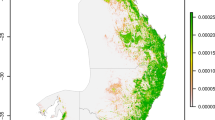Abstract
In spatial sampling, we collect observations in a two-dimensional framework. Careful attention is paid to the quantity of the samples, dictated by the budget at hand, and the location of the samples. A sampling scheme is generally designed to maximize the probability of capturing the spatial variation of the variable under study. Once initial samples of the primary variable have been collected and its variation documented, additional measurements can be taken at other locations. This approach is known as second-phase sampling and various optimization criteria have recently been proposed to determine the optimal location of these new observations. In this chapter, we review fundamentals of spatial sampling and second-phase designs. Their characteristics and merits under different situations are discussed, while a numerical example illustrates a modeling strategy to use covariate information in guiding the location of new samples. The chapter ends with a discussion on heuristic methods to accelerate the search procedure.
Similar content being viewed by others
References
Brunsdon C, Fotheringham AS, Charlton ME (1996) Geographically weighted regression: a method for exploring spatial nonstationarity. Geogr Anal 28(4):281–298
Burgess TM, Webster R, McBratney AB (1981) Optimal interpolation and isarithmic mapping of soil properties: IV. Sampling strategy. J Soil Sci 32(4):643–659
Christakos G, Olea RA (1992) Sampling design for spatially distributed hydrogeologic and environmental processes. Adv Water Resour 15(4):219–237
Cochran WG (1946) Relative accuracy of systematic and stratified random samples for a certain class of populations. Ann Math Stat 17(2):164–177
Corsten LCA, Stein A (1994) Nested sampling for estimating spatial semivariograms compared to other designs. Appl Stochastic Models Data Anal 10(2):103–122
Cressie N (1991) Statistics for spatial data. Wiley, New York
Dalton R, Garlick J, Minshull R, Robinson A (1975) Sampling techniques in geography. Goerges Philip and Son Limited, London
Das AC (1950) Two-dimensional systematic sampling and the associated stratified and random sampling. Sankhyā 10(1):95–108
Delmelle E (2009) Spatial sampling. In: Rogerson P, Fotheringham S (eds) The SAGE handbook of spatial analysis. Sage, London, pp 54–71
Delmelle E, Goovaerts P (2009) Second-phase spatial sampling designs for non-stationary spatial variables. Geoderma 153(1–2):205–216
Gatrell AC (1979) Autocorrelation in spaces. Environ Plan A 11(5):507–516
Griffith DA (2005) Effective geographic sample size in the presence of spatial autocorrelation. Ann Assoc Am Geogr 95(4):740–760
Haining RP (1990) Sampling spatial populations. In: Haining RP (ed) Spatial data analysis in the social and environmental sciences. Cambridge University Press, Cambridge, pp 171–196
Hengl T, Rossiter DG, Stein A (2003) Soil sampling strategies for spatial prediction by correlation with auxiliary maps. Aust J Soil Res 41(8):1403–1422
Madow LH (1946) Systematic sampling and its relation to other sampling designs. J Am Stat Assoc 41(234):204–217
Madow WG (1953) On the theory of systematic sampling. III. Comparison of centered and random start systematic sampling. Ann Math Stat 24(1):101–106
Madow WG, Madow LH (1949) On the theory of systematic sampling. I. Ann Math Stat 15(1):1–24
Matérn B (1960) Spatial variation. Springer, Berlin/Heidelberg/New York
Matheron G (1963) Principles of geostatistics. Econ Geol 58(8):1246–1266
McBratney AB, Webster R (1981) The design of optimal sampling schemes for local estimation and mapping of regionalized variables: II. Program and examples. Comput Geosci 7(4):331–334
McBratney AB, Webster R (1983) Optimal interpolation and isarithmic mapping of soil properties: V. Co-regionalization and multiple sampling strategy. J Soil Sci 34(1):137–162
McBratney AB, Webster R, Burgess TM (1981) The design of optimal sampling schemes for local estimation and mapping of regionalized variables: I. theory and method. Comput Geosci 7(4):335–365
Müller W (1998) Collecting spatial data: optimal Design of Experiments for random fields. Physica-Verlag, Heidelberg
Olea RA (1984) Sampling design optimization for spatial functions. Math Geol 16(4):369–392
Overton WS, Stehman SV (1993) Properties of designs for sampling continuous spatial resources from a triangular grid. Commun Stat 22(9):2641–2660
Rogerson PA, Delmelle EM, Batta R, Akella MR, Blatt A, Wilson G (2004) Optimal sampling design for variables with varying spatial importance. Geogr Anal 36(2):177–194
Russo D (1984) Design of an optimal sampling network for estimating the variogram. Soil Sci Soc Am J 48(4):708–716
Stevens D, Olsen A (2004) Spatially balanced sampling of natural resources. J Am Stat Assoc 99(465):262–278
Thompson SK (2002) Sampling, 2nd edn. Wiley, New York
Van Groenigen JW, Stein A (1998) Constrained optimization of spatial sampling using continuous simulated annealing. J Environ Qual 27(5):1078–1086
Van Groenigen JW, Siderius W, Stein A (1999) Constrained optimisation of soil sampling for minimisation of the kriging variance. Geoderma 87(3–4):239–259
Warrick AW, Myers DE (1987) Optimization of sampling locations for variogram calculations. Water Resour Res 23(3):496–500
Yfantis EA, Flatman GT, Behar JV (1987) Efficiency of kriging estimation for square, triangular and hexagonal grids. Math Geol 19(3):183–205
Author information
Authors and Affiliations
Corresponding author
Editor information
Editors and Affiliations
Rights and permissions
Copyright information
© 2019 Springer-Verlag GmbH Germany, part of Springer Nature
About this entry
Cite this entry
Delmelle, E.M. (2019). Spatial Sampling. In: Fischer, M., Nijkamp, P. (eds) Handbook of Regional Science. Springer, Berlin, Heidelberg. https://doi.org/10.1007/978-3-642-36203-3_73-1
Download citation
DOI: https://doi.org/10.1007/978-3-642-36203-3_73-1
Received:
Accepted:
Published:
Publisher Name: Springer, Berlin, Heidelberg
Print ISBN: 978-3-642-36203-3
Online ISBN: 978-3-642-36203-3
eBook Packages: Springer Reference Economics and FinanceReference Module Humanities and Social SciencesReference Module Business, Economics and Social Sciences




